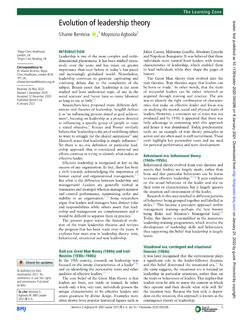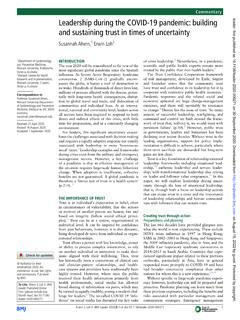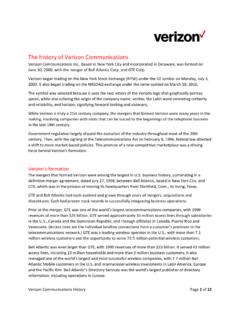Transcription of Leadership in the NHS - BMJ Leader | A journal for ...
1 1 Kline R. BMJ Leader 2019;0:1 4. in the NHSR oger Kline CommentaryTo cite: Kline R. BMJ Leader Published Online First: [please include Day Month Year]. School, Middlesex University, Barnet, London, UKCorrespondence toRoger Kline, Business school, Middlesex University, Barnet, London NW4 4BT, UK; roger@ kline. org. ukReceived 19 June 2019 Revised 9 August 2019 Accepted 1 September 2019 bmjleader. bmj. com Author(s) (or their employer(s)) 2019. Re- use permitted under CC BY- NC. No commercial re- use. See rights and permissions. Published by : essenTIal Leadership prerequIsITe or opTIonal exTra?In healthcare, Leadership is decisive in influencing the quality of care1 and the performance of How staff are treated significantly influences care provision and organisational performance so understanding how leaders can help ensure staff are cared for, valued, supported and respected is important. Research suggests inclusion is a critical part of the may be regarded as the extent to which staff believe they are a valued member of the work group, in which they receive fair and equitable treatment, and believe they are encouraged to contribute to the effectiveness of that group.
2 Inclu-sive workplaces and teams value the difference and uniqueness that staff bring and seek to create a sense of belonging, with equitable access to resources, opportunities and outcomes for all, regardless of demographic differences. Inclusive organisations are more likely to be psychologically safe work-places where staff feel confident in expressing their true selves, raising concerns and admitting mistakes without fear of being unfairly hospital settings, managing staff with respect and compassion correlates with improved patient satisfaction, infection and mortality rates, Care Quality Commission (CQC) ratings and financial performance4 as well as lower turnover and absen-teeism. By contrast, disrespect in medicine is a threat to patient safety because it inhibits collegi-ality and cooperation essential to teamwork, cuts off communication, undermines morale and inhibits compliance with and implementation of new prac-tices.
3 5 Yet, 24% of NHS staff in England report that they are subject to bullying, harassment or abuse by fellow workers and managers, impacting on increased intentions to leave, job satisfaction, organisational commitment, absenteeism, presen-teeism, productivity and the effectiveness of teams, costing the NHS at least billion The NHS has an extraordinarily diverse workforce, but workforce and NHS staff survey data show many staff experience systematic discrimination in many aspects of their NHS working lives notably in recruitment, development, disciplinary action and through bullying which are likely to adversely impact on patient care and NHS is a complex archipelago of national and local bodies, networks, commissioners, regulators and providers. Though the Health and Social Care Act 2012 changed the relationship between Minis-ters and Arm s Length Bodies, it made little change to how the NHS workforce was managed and led with a continuing stream of expectations, require-ments, targets, inspections and funding decisions which fundamentally influence workforce culture and Leadership .
4 The dominant cultures within those national bodies deeply influence behaviours and priorities at local level. Robert Francis blamed the failings of Mid Staffordshire Foundation Trust on an institutional culture which put the business of the system ahead of patients . Evidence to his Public Inquiry concluded there was a pervasive culture of fear in the NHS and certain elements of the Depart-ment for Health. The NHS has developed a wide-spread culture more of fear and compliance, than of learning, innovation and enthusiastic participation in improvement .7 Top- down management , exacer-bated by government policies, contributed to wide-spread poor treatment of staff. There was a failure to mitigate that poor first reason was denial. In his Public Inquiry report, Francis concluded that there lurks within the system an institutional instinct which, under pressure, will prefer concealment, formulaic responses and iavoidance of public criticism and an institutional culture which ascribed more weight to positive information about the service than to infor-mation capable of implying cause for concern.
5 8 The pressure to send comfort seeking rather than difficult information upwards is strong. Example: 2 years after the Francis Report, when presenting a Trust Board with their own (dreadful) data on race equality, one Non- Executive Director asked where my data came from. I explained it was from the Trust s own web site. The Board had not been second, linked, reason is that we often struggle to have honest conversations when mistakes or poor behaviour occur, whether about bullying or racism or in appraisals or feedback. We may prefer (in society, in workplaces, in teams) to live in false harmony since any type of change creates conflict even though sustained efforts to address conflict can pay dividends for staff and The result can be doubly challenging staff who are unable to share their concerns and managers anxious about even seeking them or having honest informal conversations as protective hesitancy 10 is triggered, since both may not feel it is psycholog-ically safe to have such discussions.
6 Without trust, people may just shut down leaving no capacity to have honest conversations or be vulnerable, crit-ical in examining options in, for example, clinical decision- third reason is the mismatch between demand and resources. Two decades of control totals , savings targets and staff shortages have left local leaderships under immense pressures, often fearful of blame and knowing senior Leader turn-over is astonishing. Example: the Mid Staffordshire on February 1, 2022 by guest. Protected by : first published as on 23 September 2019. Downloaded from 2 Kline R. BMJ Leader 2019;0:1 4. NHS Trust Board agreed in January 2005 that 180 posts had to go because the trust had a statutory requirement to break even at the end of the financial year , yet, when I trawled through Trust Committee minutes between 2005 and 2008, I found no mention of the countervailing duty of care to patients (or indeed staff).
7 11 Such tensions continue to exist fourth (crucial) reason is a fundamentally flawed human resources (HR) paradigm which, until recently, has dominated much NHS practice on tackling discrimination, bullying, whis-tleblowing and disciplinary action. Policies, procedures and training have been seen as key to safe, effective means whereby individual staff can raise concerns about bullying, discrimina-tion, unfair disciplinary action and unsafe practice. But research suggests this approach is fundamentally flawed as a means of improving organisational Such methodological indi-vidualism is underpinned by the individualistic nature of UK employment law and has dominated the treatment of NHS staff. A response to bullying that is focused on individualism may also treat toxic Leadership behaviours as the exception whereas data and research suggests they are Example: the NHS Employers guidance on bullying at work (2006 2016) stated employers can only address cases of bullying and harassment that are brought to their attention ,14 yet, employers had (and have) a wealth of local data on prevalence which could have enabled them to be proactive and HR paradigm has also driven the Ministerial response to whistleblowing, much of which has focused on (unsuccess-fully) protecting those individuals raising concerns rather than changing the organisational climate in which such concerns are ignored or Similarly, until recently, tackling discrimi-nation largely relied on individuals raising concerns despite the likelihood that legitimate complaints would not be upheld and would certainly not change institutional discrimination.
8 Progress on the compassionate and inclusive treatment of staff may be seen as too difficult for many teams and organisations, especially if the behaviours of national bodies do not match their exhor-tations to local bodies. Yet, the evidence is that when sustained evidenced interventions, applying human factors science and incentivising a learning culture not blame, replace a retributive culture with a restorative one, there are very substantial gains for staff and substantial benefits to organisations, saving 2% of staffing costs in one fifth reason is that, unlike NHS clinical interventions, we have too rarely asked of HR interventions why do you think this is likely to work? For example, in response to bullying or discrimination, the default answer has been more training . Yet, the largest study of diversity initiatives found that attempts to reduce managerial bias through diversity training and diversity evaluations were the least effective methods of increasing the proportion of women in management .
9 17 Similarly, Unconscious Bias Training, widely used in the NHS, may be helpful but the evidence it changes decision- making is It is difficult to understand why HR directors and Boards did not ask whether initiatives on diversity, bullying or whistleblowing were eviden-tially final reason has been a failure to systematically use the decisive influence of management and Leadership to help create a culture in which staff (including managers) are valued and respected. After all, hospitals with more managers achieve better clinical and financial performance, higher patient satisfaction and reduced infection rates than those with fewer , or how we do things round here , is shaped by formal organisational values (NHS Constitution and local policies), by values, behaviours and knowledge that staff learn, and (crucially) by how an organisation s leaders behave. What leaders focus on, talk about, pay attention to, reward and seek to influence, tells staff what Leadership values they should take note Yet, the NHS Long Term plan (2019) devotes less than two pages to lead- ership and talent know that leaders who demonstrate a commitment to high quality and compassionate care directly affect clinical effective-ness, patient safety and experience, the health, well- being and engagement of staff and the extent of innovation.
10 Evidence of the links between psychological safety, supportiveness, positivity, empathy, Leadership (in aggregate compassionate Leadership ) and innovation is deep and Without such a focus teams may be more vulnerable to learnt helplessness or outright lack of psychological safety, unaddressed conflict and dissonance between financial and performance targets and the motivations of staff to care can be demoralising. As one Clinical Director told me recently staff feel ground down by talk of effi-ciency and throughput because in a time of resource famine this can take the humanity out of what we came into medicine to do . Such concerns are well captured by Unwin s focus on embed-ding relational intelligence (kindness, emotional intelligence) as powerfully as rational intelligence (regulation, measurement and efficiency)21 Leaders who regard staff primarily as a cost rather than an asset and who fail to listen to the most junior cleaner, talk with the admin clerk, admit mistakes or engage in repeated acts of kindness and support are not role models for their staff.




